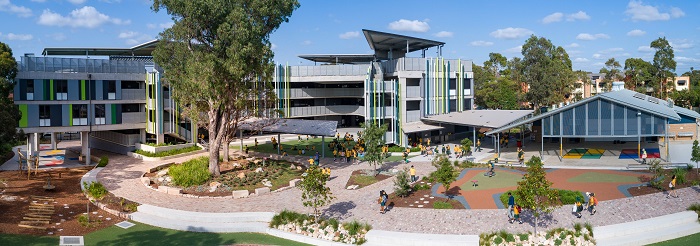Well-designed landscapes promote sustainability and inclusion while creating spaces that stimulate curiosity and enjoyment – encouraging children to thrive.
Interaction with nature promotes a child’s growth and wellbeing, making it imperative for schools to extend the learning environment into their outdoor landscapes.
Sydney-based landscape architecture practice CONTEXT says it is invested in harnessing good design to encourage and support children to spend more time outdoors and engage in free play and hands-on learning.
CONTEXT director and landscape architect Hamish Dounan works with school communities to design outdoor landscapes that support learning and development.
“With studies citing that increased time in nature aids the growth, development and wellbeing of children, biophilic design in education settings is critical,” says Dounan. “Outdoor environments at schools can, and must go far beyond the formal ‘play’ provision.”

Homebush West School | Photography: Mike Chorley
Referencing the studio’s work with TKD Architects to upgrade and extend Homebush West School in New South Wales, Dounan shares four key areas he and his team focus on when designing outdoor classrooms.
“Designing outdoor spaces that can be used and enjoyed by everyone in the school is critical,” says Dounan. Through extensive consultation with the school community and the wider project team – including local government, teachers, parents and students – landscape architects can ensure that design interventions are inclusive and accessible to all across gender, ability, neurodiversity, and cultural background.
Outdoor spaces for students can range from active sports to quiet play areas, as well as outdoor classrooms, refuge areas and productive gardens. At Homebush West School, the landscape design incorporates details such as widened, recycled brick pathways, sensory and productive gardens, signage, and plant labels, ensuring everyone feels a sense of inclusion.
Designing resilient landscapes that are sustainable in the long-term is another important consideration. “Guided by our team of expert horticulturalists, our ecological strategies focus on planting native species – adapted to local conditions, they require minimal maintenance,” says Dounan. The bush play garden at Homebush West School has created a habitat that supports local wildlife such as warbling magpies, lizards and dragonflies. Mulch trails and stepping stone logs create an active and imaginative play space for students while also inculcating in them an appreciation for Australian ecology.
“Through including rainwater collection measures such as swales and rain chains, which are then used in the productive gardens, alongside including solar panels and wind turbines, the students are encouraged to learn about ecological cycles and responsible resource use.”
Dounan also underlines the importance of designing natural multifunctional spaces, which can be adapted over time to meet changing recreational and educational needs, rather than creating fixed use spaces for a specific sport or activity. For instance, the rooftop garden at Homebush West School includes a large open lawn area, alongside several play structures between soft-fall mounds and a small amphitheatre and running track, each area designed to accommodate different sized groups and different student needs.
The shaded tiered amphitheatre at Homebush West School is a space that can be used in all weather conditions. Canopy cover can create both shaded and fully-covered environments which, when integrated with moveable furnishings such as outdoor rugs and beanbags can be used as play and learning spaces throughout the year.
“The setting – whether that be urban or rural – is also critical to informing design decisions, particularly around curating a material palette, considering how colour, texture, composition and source will stimulate the students and respond to the climate in different ways,” says Dounan. Notably across all projects, the studio prioritises using natural materials that – as far as possible – are locally manufactured.
In response to the brief to provide seating throughout the outdoor spaces at Homebush West School, CONTEXT designed curved and straight benches made from precast concrete and natural materials such as sandstone logs. Encircling planting beds and looking out to the playground, the seating design promotes informal social gatherings and interactions, while providing opportunities for group learning in an outdoor setting.
Photography: Mike Chorley

